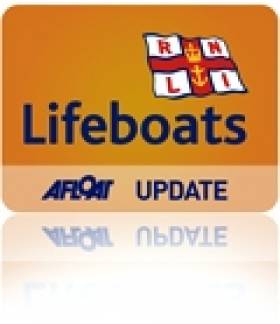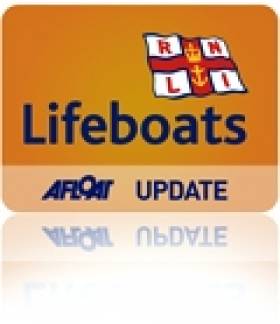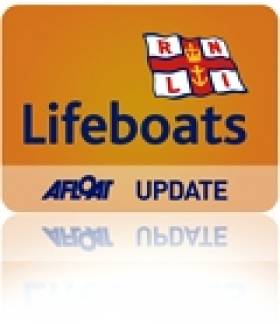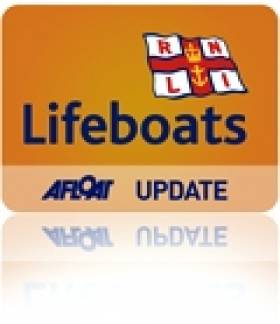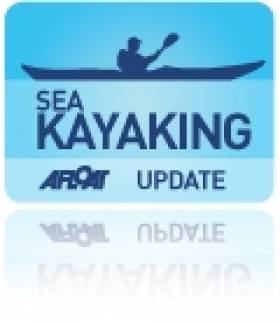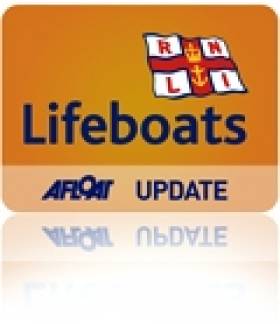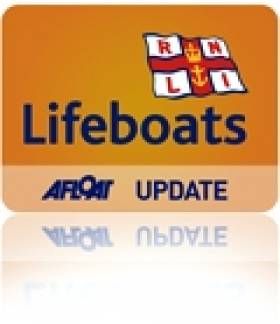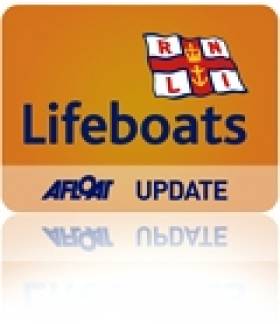Displaying items by tag: Lifeboats
Wicklow Lifeboat Rescues Jetskier After Engine Cuts Out
#RNLI - Wicklow RNLI's inshore lifeboat launched at 2.25pm yesterday afternoon (Friday 3 July) to assist a jetskier north of the harbour.
The jetskier had set off from Wicklow and was about a half mile offshore when the engine cut out, leaving him adrift and unable to get ashore.
Within minutes of launching, the lifeboat reached the casualty, who was then taken on board with his jetski in tow back to Wicklow Harbour.
The inshore crew on this callout were helm Dave O'Leary, Lisa O'Leary and Carol Flahive.
#RNLI - The RNLI will have a fully operational lifeboat station in Belfast City from 9am tomorrow 2 July right through to Sunday evening 5 July for the Tall Ships Races.
With up to 750,000 visitors expected in Belfast over the next four days, a number of volunteers from Bangor and Red Bay lifeboat stations will be on call to provide a 24-hour search and rescue service during the event.
The crew will operate from a temporary lifeboat station located in Belfast Harbour Marina and will respond to any emergency on Belfast Lough using an Atlantic 85 relief lifeboat.
During the Tall Ships Parade on Sunday, both the Atlantic 85 lifeboat and an all-weather Trent class lifeboat crewed by Donaghadee RNLI will be operational on Belfast Lough for search and rescue capabilities.
Speaking ahead of the Tall Ships Races, RNLI divisional operations manager Darren Byers said: "For the duration of the weekend and specifically to accommodate the large numbers expected to descend on Belfast to watch the Tall Ships spectacle, the RNLI will be fully operational at the heart of where all the activities will be taking place.
"Belfast RNLI will operate for four days only supported by its nearest lifeboat stations at Bangor and Larne. This means should there be an emergency during the event, we can reduce the time it takes to get on scene while maintaining a business as usual operation at our flank lifeboat stations."
The RNLI will have a significant presence on site throughout the weekend and has been honoured to be chosen by Tall Ships Belfast as one of five key maritime charities to benefit.
As well as a fully operational lifeboat station, the RNLI will have an all-weather Trent class lifeboat afloat which can be viewed from the quayside at Belfast Harbour Marina. Volunteer lifeboat crew will be on hand to answer any questions and to demonstrate how they use the lifeboat for search and rescue.
RNLI lifeguards who patrol 10 beaches in Northern Ireland during the summer season will also be displaying the rescue water craft and lifesaving kit they use.
Visitors to the RNLI areas can also take part in the ‘Get Your Kit on Challenge’. This is a timed challenge that pits members of the public against the clock to see how long it takes them to put on an inshore lifeboat crew member’s full kit: dry suit with yellow wellies, lifejacket with crotch straps and helmet. The lifeboat crew do this in seconds as they race to launch the lifeboat on a callout.
RNLI community fundraising manager Nicola Kelly is looking forward to the event. "The RNLI is hosting a variety of engaging activities at Tall Ships Belfast and we are honoured to have been selected as one of the official charities to benefit," she said.
"We are looking forward to welcoming visitors to the RNLI areas and hope that in doing so we can provide an entertaining, informative and interesting aspect to the full programme being provided.
"As well as saving lives at sea and on inland waters, the RNLI also provides education along with sea safety advice and demonstrations and we hope spectators can sample a flavour of that this weekend."
#RNLI - Skerries RNLI brought four people to safety on Sunday afternoon (28 June) after their racing yacht began taking on water after striking rocks near one of the islands off Skerries.
Volunteers launched their Atlantic 85 inshore lifeboat Louis Simson shortly after 4pm when reports were received by Dublin Coast Guard that a yacht had struck rocks near Colt Island.
The lifeboat, with Philip Ferguson at the helm and crewed by Eoin Grimes, Simon Shiels and Emma Wilson, made its way directly to the area reported, where the casualty vessel was quickly located.
Having freed themselves from the rocks, the yacht and its crew were making their way towards Skerries Harbour, though water was leaking into the yacht through damage to the hull.
The lifeboat was positioned alongside and a crew member boarded, bringing the salvage pump carried aboard the lifeboat.The yacht was then taken under tow and brought to the safety of Skerries Harbour, where several more volunteer crew joined the others and assisted in getting the yacht on to a trailer and taken out of the water.
Speaking after the callout, Skerries RNLI volunteer lifeboat press officer Gerry Canning said: "The RNLI spends a lot of time and effort making sure that our volunteers have exactly the equipment they need to cater for any kind of emergency.
"In emergencies such as this, the salvage pump can be invaluable."
#RNLI - Ireland's second busiest coastal lifeboat station is still without a pontoon for the safe boarding and alighting of crew and casualties, as the Sunday Independent reports.
Dun Laoghaire RNLI still uses a motor tender to transfer between the lifeboat station next to the National Yacht Club and its all-weather lifeboat anchored in the harbour.
This has proved to be a safety issue in the past, with one crew member breaking an arm while boarding the lifeboat in rough weather four years ago.
Lifeboat volunteers are also forced to use the NYC's pontoon when bringing casualties ashore, which can be problematic when its berths are full such as in the summer season.
The newspaper highlights the projected €200,000 cost of funding a dedicated launch pontoon for the lifeboat station compared to the multimillion investments around it as part of the Dun Laoghaire Harbour Masterplan, including an urban beach and a proposed new cruise liner berth.
The Sunday Independent has more on the story HERE.
Union Hall Lifeboat Rescues Five From French Yacht
#RNLI - Union Hall RNLI rescued five men after their yacht was in danger of hitting rocks off the coast of West Cork on Friday evening (26 June).
The volunteer lifeboat crew was alerted shortly after 5pm following a report from the Irish Coast Guard that a 54ft French yacht, with five men onboard, was dragging an anchor on a lee shore in the inner harbour in Glandore village.
The inshore lifeboat, helmed by Stephen Hurley and with crew members Johnny McKenna and Sean McCarthy, launched at 5.15pm and was on scene minutes later. Weather conditions at the time were described as good with a Force 4-5 westerly wind blowing.
Once on scene, the lifeboat crew observed that the vessel was in danger of hitting rocks after its propeller had got tangled in a rope. The yacht’s crew had put out an anchor but it then started to drag on a lee shore.
Having assessed the situation, one lifeboat crew member went aboard the yacht before a towline was quickly established to divert the vessel from hitting the rocks.
The lifeboat crew then proceeded to bring the vessel and the five men onboard safely back to Union Hall.
Speaking following the callout, Union Hall RNLI deputy launching authority Jim Moloney said: "The quick response of the lifeboat crew prevented a more serious situation developing this evening and I would like to commend our volunteers for using their skills and training to bring the yacht out of danger."
Exhaustion Takes Toll On German Kayaker Off Cornwall
#Kayaking - Just days after embarking on an ambitious kayaking expedition from Kinsale to Germany, pizza oven company boss Hendrik Lepel was picked up by the RNLI after calling for help off Cornwall.
Padstow's volunteer lifeboat launched around 12am in the early hours of yesterday morning (Thursday 25 June) to rescue the German kayaker, who was suffering from fatigue after 30 hours at sea and unsure how to reach Padstow Harbour.
Quickly locating the four-metre kayak The Flying Northman, which was set up with an outrigger and sails, the crew took the tired casualty onboard and towed the kayak into Padstow where his support crew were waiting.
"It was a beautifully calm and flat night, with very light winds," said deputy second coxswain and mechanic Michael England. "The chap had been at sea for 30 hours and was extremely tired.
"Although he was also equipped with an outboard engine, he’d used the fuel and under sail it would have been a long passage into Padstow. Unfamiliar with the area, he was also unsure of the best way into the harbour.
"He did exactly the right thing to call for help, and although it was a late night for the crew, we didn’t get back to the station until 2.20am, we were happy to help him out."
Here's hoping Lepel – who admitted earlier to "not being experienced" at offshore kayaking – can resume his journey to Rostock in time to meet the tall ships without further incident!
#RNLI - Rosslare Harbour RNLI assisted six people in the early hours of this morning (Friday 26 June) after their yacht got into difficulty off the Wexford coast.
Volunteers were alerted shortly before 2.30am following a report from the Irish Coast Guard that a 14m yacht with six people onboard was experiencing difficulties 12 miles south east of Rosslare Harbour.
The all-weather lifeboat under coxswain Keith Miller launched at 2.55am and made its way to the scene. Weather conditions at the time were described as good with some light rain and a south east Force 4 wind blowing. Visibility was fair.
Arriving on scene at approximately 3.30am, the lifeboat crew observed that no one was in any immediate danger. The yacht, which was on passage from Poland and making its way to Dublin, had got entangled in lobster pots.
Having assessed the situation, two crew from Rosslare Harbour RNLI proceeded to launch the small inshore Y boat from the all-weather lifeboat so that they could get as close as possible to the yacht.
A towline was established and the lifeboat began to gently pull until the rope was untangled and the yacht was freed. The lifeboat stood by for 15 minutes before the yacht resumed normal passage.
Speaking following the callout, Rosslare Harbour RNLI lifeboat press officer Jamie Ryan said: "The crew of the yacht did the right thing this morning and raised the alarm when they got into difficultly.
"It was an early call out for our volunteers but they were delighted to be able to assist and ensure the six crew members on the yacht could resume their passage to Dublin safely."
Wicklow Lifeboats Launch To Report Of Floating Object
#RNLI - Both Wicklow RNLI lifeboats launched yesterday afternoon (Saturday 20 June) at 3.10pm to investigate a report of an object floating in the sea off the beach at Brittas Bay.
A vigilant lifeguard on duty at Brittas Bay contacted the Irish Coast Guard to report a white object in the water about two miles off the popular tourist beach.
Both lifeboats were on scene 20 minutes after launching, and they conducted an extensive search from Mizzen Head back towards Wicklow Head.
Conditions in the area were good, with a slight sea state and wind westerly force two. Visibility in the search area was good.
During the search the lifeboat volunteers made contact with some boats in the area but none required any assistance.
Following an extensive search of the area and no boat found to be in difficulty, the coastguard stood down both lifeboats at 4.05pm, and they were back in their station by 4.30pm.
The crew on the all-weather lifeboat were coxswain Ciaran Doyle, mechanic Connie O'Gara, John Vize and David Collard. The inshore crew were helm Graham Fitzgerald, Peter McCann and Matt Doyle.
Hot Tub Adrift In English Channel, Vessels Warned
#HotTub - Vessels in the English Channel have been warned to keep watch for a hot tub adrift in the water after a houseboat sank near Brighton this week.
On Wednesday 17 June, Newhaven RNLI attended to a tug towing two 22-metre houseboats on their way to the Thames area, one of which began taking on water and sank within 20 minutes.
As YBW reports, the lifeboat and tug crew were able to collect some debris that floated to the surface from the sunken houseboat.
But the hot tub was too large to recover, and its last known position was passed to Dover Coastguard.
Wexford Lifeboats Assist Two After Yacht Breakdown
#RNLI - Volunteer lifeboat crew from Wexford and Rosslare Harbour RNLI launched on Sunday (14 June) to go to the assistance of two people onboard a 37ft yacht which got into difficulty off Wexford’s east coast.
Wexford RNLI launched their inshore lifeboat first at 4.30pm following reports that a yacht had suffered engine failure two miles south west of Raven’s Point. They then requested the assistance of their colleagues at Rosslare Harbour RNLI who subsequently launched their all-weather lifeboat.
Weather conditions at the time were described as good with a Force 5-6 northerly wind blowing. The sea was calm and there was good visibility.
The Wexford lifeboat, helmed by Lorraine Galvin and with crew members Simon Gulliver and Martin Conway onboard, arrived on scene at 5pm. Gulliver, who is also Wexford RNLI’s station mechanic, boarded the yacht and assessed the situation.
After inspection, Gulliver was able to get the fuel system working again and ran the boat for 10 minutes to ensure the vessel was operating smoothly. Rosslare Harbour RNLI stood by meanwhile, ready to assist if required. Following the checks, the yacht was able to continue on its journey.
Speaking following the callout, Galvin said: "We were delighted to be able to assist the two people who got into difficulty on their yacht today.
"Simon’s skills as mechanic paid off as he successfully managed to get the yacht back underway and in doing so avoided a lengthy tow back to shore."





























